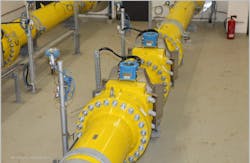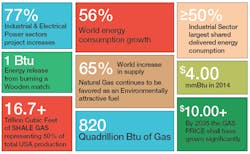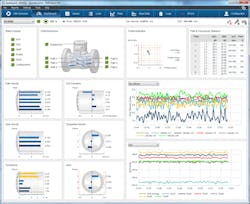How Ultrasonic Flowmeters Measure Natural Gas More Efficiently
The natural gas industry is a key segment of many global economies. It is stated, within the public domain1,2, that natural gas energy consumption is set to reach 23 percent of world energy demand by 2040. It is the fastest-growing fuel, rising at approximately 1.7 percent per year between 2010 and 2014. This represents a predicted consumption in the order of 820 quadrillion Btu of gas.
Source: Honeywell Process Solutions
Of notable importance to the oil & gas industry is the phenomenal growth in unconventional gas production alongside that of conventional resources, and, further, the critically important requirement for metering that spans the entire gas value chain. Flowmetering is essential to quantify the bulk movement of gas from wellhead to the point of flame.
Companies in the natural gas industry have critical operational demands. They require accurate flowmetering technology to measure and analyze the quality and volume of gas throughout its value chain. The industry categorizes its meters as being: (1) Traditional; or (2) New Technologies. This is a relative categorization based on a historical timeline that extends to a number of technological centuries. Frequent use of this terminology is evident within published material, such as The World Market for Ultrasonic Flowmeters, 3rd Edition, a marketing report dedicated to ultrasonic flowmetering.3 However, traditional flow measurement devices can be, within certain applications, unreliable and costly to install and maintain, which is why newer technologies have been developed.
One such new technology is ultrasound-based flow measurement. For natural gas processes with dry, wet, or corrosive and abrasive gases, or requiring bi-directional measurement with minimal or no pressure drop, ultrasonic measurement devices generally offer better performance, greater reliability, and lower capital and ownership costs than mechanical-type meters.
Ultrasound is employed in electronic, navigational, industrial, and security applications. It is also used in medicine to view internal organs of the body. Examples of audible sound surround us in everyday life, and man has been pursuing a deeper knowledge of the influence of sound for centuries. The speed-of-sound (sometimes called velocity-of-sound) is known to be the speed at which sound travels in a given medium under specified conditions.
The first known attempt to measure the speed-of-sound (SoS) in air (a gas) was by Pierre Gassendi, who, in 1635, timed the delay between the powder flash of a distant cannon and the explosion that sounded later. By the early 1700s, estimates for the speed-of-sound using cannon fire were within 0.5 m/s (1.64 ft/s) of modern-day values. This was substantiated by the first analytical determination of SoS given by Isaac Newton (1642 to 1727) in Proposition 49 of Book II of the Principia. For sea-level air at a typical ambient temperature, he computed a value of 298 m/s (979 ft/s), which is too low by about 15 percent, the true value being closer to 340 m/s (1116 ft/s). Nevertheless, the basic method conceived by Newton was essentially correct. As early as the 1800s, experiments to determine the SoS for water were recorded by Colladon and Sturm in their reported experiment on Lake Geneva.
Metering, in one form or another, has existed for many centuries, although techniques based on ultrasound have only been more recently utilized. Records dating back to the 1930s indicate the use of Doppler techniques and, circa 1970, the transit-time method. It is important to note that all metering techniques are valid when considering a specific end-use or application; however, the exclusive use of transit-time for fiscal gas meters has developed over the last 40 or more years. Significant developments are recorded with reference to meters that employ more than one measurement point (known as a “path”) within any single, dedicated metering device.
Over the past 30 years, gas ultrasonic multi-path meters have transitioned from the engineering laboratory to wide commercial usage as the primary device-of-choice to measure gas volume for fiscal accounting. The metering path arrangements are notably different (by physical configuration/location) between various designers/manufacturers, however the basic underlying principles remain the same.
The development of published standards4, 5, 6, 7 often increases end-user confidence of a particular metering technology, of which the most notable ultrasound example is that of the American Gas Association’s Report No. 9.4 There is no doubt that as meter technologies develop, the requirement for impartial standards grows exponentially and is often an indication of the uptake rate of that technology.
Standards are updated from time to time to align with both the technology and its market developments that are in most parts based on experiential learning from a vast number of sources. Sources that extend beyond the manufacturer to the specific technology end-users, calibration facilities, independent research facilities, type-testing and approvals agencies, independent consultants, other technologies representatives, along with any other party that has a technology touch point.
Operator dashboard used for online validation of an ultrasonic flowmeter (Image courtesy Honeywell Process Solutions)
The acceptance of multi-path ultrasonic flowmeters by gas pipeline companies has occurred due to the following features and benefits:
- Reliability
- Repeatability
- Capacity
- Rangeability
- Low maintenance
- Adoption of industry standards for fiscal measurement applications
- Condition Based Monitoring (online, real-time).
If one is to consider the specific application of ultrasonic meters for custody transfer or allocation metering, there are vast sources of published data, in direct response to published standards, in which it can be seen that an optimized path layout would be one with a three-dimensional element to its design. Such a layout provides for a complex, yet accurate and repeatable measurement during both ideal and severely disturbed flow conditions. One such path layout was initially developed in the 1990s; although there are other examples of multi-path meters that may be seen within the standards documents. This unique six-path arrangement is optimized for three-dimensional accuracy and provides performance benefits compared to the traditional two-dimensional paths. The three-dimensional element of the design is shown as follows.
Virtually all ultrasonic flowmeters used for fiscal measurement are flow calibrated at metrological traceable test laboratories. Flow tests are conducted at multiple points over the flowmeter’s operating range to characterize its performance curve. Meter factor(s) are then calculated and applied to correct the output to the laboratory’s traceable and certified reference standards.
An advantage of modern ultrasonic meters is that once a meter is flow calibrated, diagnostic assessments can describe performance (i.e., meter factor shifts due to a fault in the device’s operating elements, such as transducers and/or processing electronics) so that frequent (typically defined as once per calendar year) re-calibration generally isn’t required, although some regulatory authorities mandate re-certification at set intervals, these mandates vary by local jurisdiction. This diagnostic assessment is growing in its complexity and is being driven by the ultimate requirement to validate the device online and real-time to ensure its optimum performance.
All commercially viable gas ultrasonic meters offer diagnostic outputs that indicate meter operating condition, up to and including the ability to judge whether or not measured bulk flow rate output is accurate. These diagnostics have developed over several decades and must continue to do so in the interest of achieving the best metered performance. The nature of the meter’s operating principle helps define these outputs and also their interpretation for which the more widely used terminology is Condition Based Monitoring (CBM). CBM is a collection of an individual meter’s discrete diagnostics brought into a piece of dedicated software that assists the end-users to interpret the various datasets. Combinational datasets are combined to create more intuitive graphical representations supported, quite often, by the quick reference color-coding of key diagnostic data.
READ ALSO: Ultrasonic Flowmeters — An Evolving Technology Expands Its Application Reach
Transit-time ultrasonic meters depend on transmission and subsequent recognition of sonic pulses using precise timing measurements and known geometry (i.e., path length and angle) to accurately measure gas velocity. Manufacturers have incorporated signal (pulse) recognition and processing algorithms as well as highly accurate clocks to make timing measurements. Therefore, signal generation, signal reception, signal strength, signal-to-noise ratio and clock accuracy are fundamental to precise and reliable meter performance. Diagnostics, such as a meter’s signal strength have been noted for decades where the strength is known to be the inverse of the electronics amplification applied to the measurement system. Prior to the implementation of dedicated software, and certainly prior to digital electronics, such a determination was achieved by the manual use of an oscilloscope.
One of the most powerful, and proven, CBM results is that of a path ratios analysis in considering multi-path meters. The analysis of the path ratios can provide a great deal of information relating the meter’s response to the actual fluid hydraulics within its location. Under disturbed and non-ideal fluid flow conditions, defined as the flow profile not being fully developed and classic, there is valuable information contained within such a path’s analysis. However, it should be noted that there are many situations where there is no one single analysis of a single diagnostic but a combination of several. This is where the technology will continue to develop. Many end-users are keen to continue to explore the topic of online, in-situ validation for which CBM is central to success.
Online and in-situ validation is key to the continued growth of ultrasonic flowmeters within the custody-transfer and allocation-metering arena. In many installations the cost in removing and recalibrating such a meter is one of the largest contributors to operational expenditure, while an end-user also wishes to maintain traceability within a predetermined audit trail. The instantaneous presentation of CBM via a dedicated software package must continue to evolve to become ever more intuitive, however it must also develop into data historian analytics. Vast data historical archives exist within many end-user businesses that include flowrate data. Creating and subsequently analyzing the much bigger CBM data is a future imperative for the industry in realizing experiential learning from data archives. As the volume of individual datasets increases, and as the total CBM packaged data is collected within an historical archive, there must be information contained therein that is not known because there is no subsequent analysis. This subject resides within the auditing arena for which there is a great deal of work to be done within the future application of ultrasonic flowmeters for custody transfer and allocation metering.
Going forward, gas—both conventional and unconventional—figures to continue to be in great demand within the global economy, and, as such, so too shall the requirement for metering. As such, existing and new standards are likely to evolve and emerge. And as most of the industrial suppliers to the gas metering industry are operating on a global basis, it would be helpful if some element of the various regional standards were globally aligned where practicable.
It is considered essential to the growth of ultrasonic flowmeters, in terms of installed base, that Condition Based Monitoring continue to be ever more intuitive from an end-users’ perspective, and that it may be used as the basis to decide on the recalibration frequency of an installed meter. Of key importance, especially for auditing, is the continued requirement to analyze historical datasets for individual meters giving rise to new experiential learning.
One very challenging area for consideration in looking into the future, is that of process historical data archives giving rise to the subject of “virtual metering,” a topic outside this article, which can significantly decrease the uncertainty in any validation activity. However, it may be considered that such an approach could lead to the ultimate goal of in-situ calibrations of ultrasonic flowmeters that is, in its own right, a vast topic for discussion within the industry. It is a discussion that has been ongoing for over two decades, but perhaps there are clues within this article as to how this may be achieved in the future.
References
1. The United States Energy Information Administration, Independent Statistics and Analysis; International Energy Outlook 2013.
2. The Centre for Strategic and International Studies Energy and National Security Program hosted the release of the U.S. Energy Information Administration’s International Energy Outlook 2013 (IEO2013), July 25; Adam Sieminski, Administrator of the EIA, presented key findings from the report. Supporting information may be located at:
- U.S. Energy Information Administration home page, ?www.eia.gov
- Short-Term Energy Outlook, www.eia.gov/steo
- Annual Energy Outlook, www.eia.gov/aeo
- International Energy Outlook, www.eia.gov/ieo
3. Flow Research Inc., The World Market for Ultrasonic Flowmeters, 3rd Edition, Book 1 and 2, Wakefield, MA, USA.
4. AGA Report No. 9, Measurement of Gas by Multipath Ultrasonic Meters, June 1998, American Gas Association, 1515 Wilson Boulevard, Arlington, VA 22209.
5. ISO 17089-1:2010 Measurement of fluid flow in closed conduits; Ultrasonic meters for gas — Part 1: Meters for custody transfer and allocation measurement.
6. BS 7965:2013 Guide to the selection, installation, operation and calibration of diagonal path transit-time ultrasonic flowmeters for industrial gas applications.
7. International Organisation of Legal Metrology Amendment 2014 to OIML R 137-1 & 2 Edition 2012 (E), Part 1: Metrological and technical requirements; Part 2: Metrological controls and performance tests.
Martin Bragg is Chief Technology Officer for Honeywell Process Solutions. Mr. Bragg is responsible for the technology portfolio of Honeywell’s Engineered Field Solutions (“EFS”) business, which is active in the market for gas and oil transmission, distribution and storage, including for individual measurands and terminal automation. He is a member of the BSI, ISO, and AGA technical committees for flow and was sponsored through his MSc by The Royal Academy of Engineering, London, which administered the Panasonic Trust. He holds an MBA with a focus on Strategy within the Private Sector. Mr. Bragg can be reached at [email protected] or +44 8701 149880.




